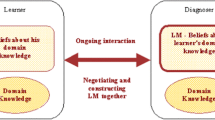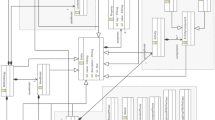Abstract
In order to reach the community interested in some basic elements of the adaptive automata theory, an interpretable language called DInAton (Didactical and Interactive Adaptive Automata Construction Language) was designed. In the language design, the criteria of similarity, orthogonality and parsimony were considered with the intention of preserving the adherence to the adaptive theory and of conceiving an interactive environment for learning its main foundations. Those requirements related to an active learning environment were met using the narrative-centered OC2-RD2 technique. As a research result, we obtained a grammar for the DInAton language that served as the basis for the development of a functional prototype with support for incremental construction of finite and adaptive automata. In addition to DInAton, we refine the OC2-RD2 technique with the idea of organizational plans used during the process of constructing an interactive narrative for the learning environment.











Similar content being viewed by others
References
Amer A (2006) Reflections on Bloom’s revised taxonomy. Electron J Res Edu Psychol 4(8):213–230
Bentley J (1986) Little language. Commun ACM 29(8):711–721
Buttignon K, Vega IS (2014) Estudo de caso da aplicação da técnica OCC-RDD em um experimento metodológico no ensino de computação. Tecnol Edu (207):51–63. ISSN:0102-5503
Cereda PRM, José Neto J (2016) AA4J: uma biblioteca para implementação de autômatos adaptativos. In: Memórias do X Workshop de Tecnologia Adaptativa—WTA 2016, Escola Politécnica da Universidade de São Paulo, pp 16–26. ISBN:978-85-86686-86-3
Cereda PRM, José Neto J (2017) XML2AA: geração automática de autômatos adaptativos a partir de especificações XML. In: Memórias do XI Workshop de Tecnologia Adaptativa—WTA 2017, Escola Politécnica da Universidade de São Paulo, pp 72–81. ISBN:978-85-86686-90-0
Chomsky N (1956) Three models for the description of language. IRE Trans Inf Theory pp 113–124. https://doi.org/10.1109/TIT.1956.1056813
Diesel A, Baldez ALS, Martins SN (2017) Os princípios das metodologias ativas de ensino: uma abordagem teórica. In: Revista Thema, vol 14, pp 268–288. https://doi.org/10.15536/thema.14.2017.268-288.404
Friedman DP, Wand M, Haynes CT (2008) Essentials of programming languages, 3rd edn. The MIT Press, Cambridge
Harlen W (2013) Inquiry-based learning in science and mathematics. Rev Sci Math ICT Edu 7(2):9–33
Jeschke M, Jeschke S, Pfeiffer O, Reinhard R, Richter T (2006) Conceptual graphs and storyboarding for problem solving strategies in mathematics. In: 2006 Annual Conference & Exposition, ASEE Conferences, Chicago, Illinois. https://peer.asee.org/773
José Neto J (1993) Contribuições ã metodologia de construção de compiladores. Escola Politécnica da Universidade de São Paulo, São Paulo, Tese de livre docência
José Neto J, Magalhães MES (1981) Reconhecedores sintáticos—uma alternativa didática para uso em cursos de engenharia. In: XIV Congresso Nacional de Informática, Sâo Paulo, pp 171–181
Kaplan RM (1994) Constructing language proprocess for little languages. Wiley, New York. ISBN 0-471-59754-6
Moran J (2015) Mudando a educação com metodologias ativas. In: Convergências Midiáticas, Educação e Cidadania: aproximações jovens, Coleção Mídias Contemporâneas, vol II, Carlos Alberto de Souza & Ofelia Elisa Torres Morales (orgs.), pp 15–33
NRC (2012) A framework for K-12 science education. National Academies Press, National Research Council, Washington DC
Pantsar-Syväniemi S, Ervasti M, Karppinen K, Väätänen A, Oksman V, Kuure E (2015) A situation-aware safety service for children via participatory design. J Ambient Intell Hum Comput 6(2):279–293
Parr T (2007) The definitive ANTLR reference: building domain-specific languages. Pragmatic Programmers, Pragmatic Bookshelf
Ramos MVM, José Neto J, Vega IS (2009) Linguagens formais: Teoria, Modelagem e Implementação, 1st edn. Bookman, Porto Alegre
Rocha RLA, José Neto J (2001) Autômato adaptativo, limites e complexidade em comparação com máquina de turing. In: Proceedings of the second Congress of Logic Applied to Technology—LAPTEC 2000, Faculdade SENAC de Ciências Exatas e Tecnologia, São Paulo
Rowlett T (2000) The object-oriented development process: developing and managing a robust process for object-oriented development. Prentice Hall, ISBN-13:978-0130306210
Vega IS (2015) Ambientes interativos híbridos de aprendizagem presencial: a técnica OCC-RDD. In: Lima JPH (ed) Anais do Fórum de Metolodogias Ativas. Pontifícia Universidade Católica de São Paulo, MetA, p 16
Vega IS (2016) Fábulas OCC-RDD: histórias didáticas para ambientes interativos híbridos e presenciais de aprendizagem. Tecnol Edu 12(212):105–118. http://www.abt-br.org.br/images/rte/212.pdf
Vega IS, José Neto J, Marcondes FS (2017) Dinaton: a didactic and interative language for learning adaptive automata by construction. Proc Comput Sci 109:1176–1181. https://doi.org/10.1016/j.procs.2017.05.393
Watt DA, Findlay W (2004) Programming language design concepts. Wiley, New York, pp I-XVIII, 1–473
Yakoub MS, Selouani SA (2017) Ontology-based framework for a multi-domain spoken dialogue system. J Ambient Intell Hum Comput 1–14. https://doi.org/10.1007/s12652-017-0625-y
Acknowledgements
We thank three anonymous reviewers for critically reading the manuscript and suggesting substantial improvements.
Author information
Authors and Affiliations
Corresponding author
Rights and permissions
About this article
Cite this article
Vega, I.S., Neto, J.J. & Marcondes, F.S. DInAton with OC2-RD2. J Ambient Intell Human Comput 10, 2585–2592 (2019). https://doi.org/10.1007/s12652-018-0735-1
Received:
Accepted:
Published:
Issue Date:
DOI: https://doi.org/10.1007/s12652-018-0735-1




